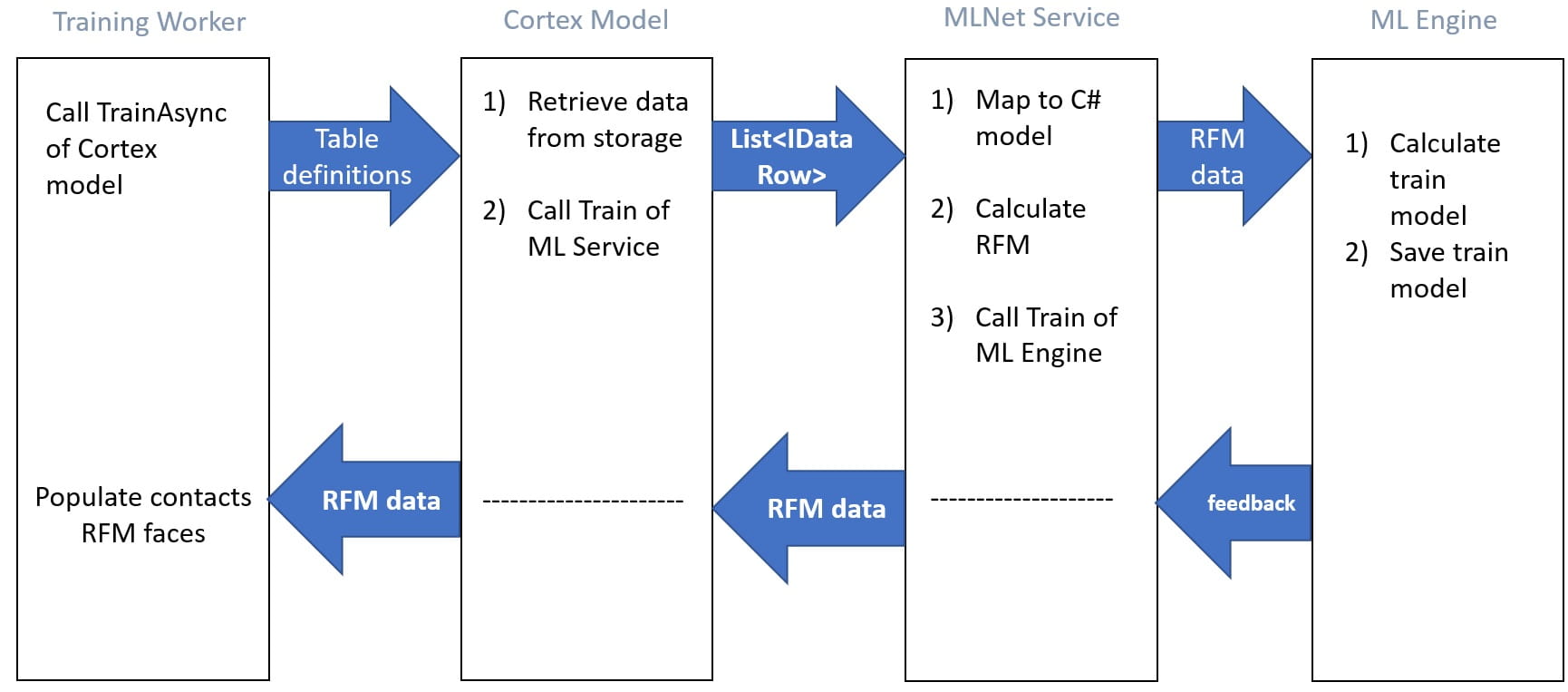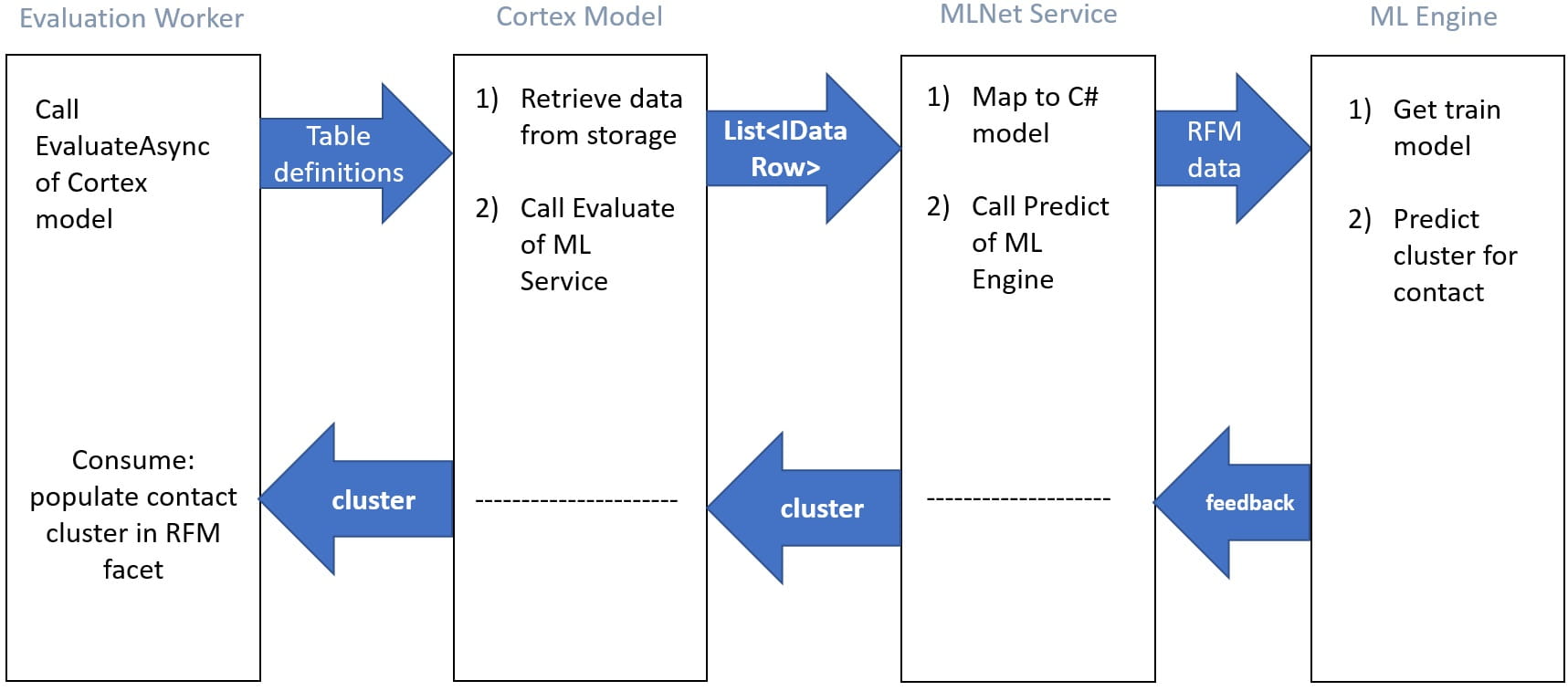In this article, we will implement the remaining logic to get a functional solution.
Let's finish with the training worker we've described in the previous part.This is a step-by-step diagram of the processes that are related to training.

-
When TrainingWorker is run it will create Cortex Model (PurchaseInteractionModel) and execute method TrainAsync of this model with provided schema and table definitions as parameters:
ModelStatistics modelStatistics = await _model.TrainAsync(_options.SchemaName, token, tableDefinitionList.ToArray()).ConfigureAwait(false); -
Cortex Model will retrieve data from blob storage (projected data with all purchases) and pass it to Train method of MLNetService:
public async TaskTrainAsync(string schemaName, CancellationToken cancellationToken, params TableDefinition[] tables) { var tableStore = _tableStoreFactory.Create(schemaName); var data = await GetDataRowsAsync(tableStore, tables.First().Name, cancellationToken); return _mlNetService.Train(data); } -
MLNetService will map data to a normal C# model and execute logic that will calculate RFM values for this model. Next, we will pass RFM values to ML Engine and return RFM values to Cortex Model:
public ModelStatistics Train(IReadOnlyList<IDataRow> data) { var customersData = CustomerMapper.MapToCustomers(data); var rfmCalculateService = new RfmCalculateService(); var calculatedScores = rfmCalculateService.CalculateRfmScores(customersData); var businessData = calculatedScores.Select(x => new Rfm { R = x.R, F = x.F, M = x.M }).ToList(); var client = new RestClient(_mlServerUrl); var request = new RestRequest(_trainUrl, Method.POST); request.AddJsonBody(businessData); var response = client.Execute<bool>(request); var ok = response.Data; if (!ok) { throw new Exception("something is wrong with ML engine, check it"); } return new RfmStatistics{ Customers = calculatedScores }; } -
Cortex Model will return RFM values to Training worker and Training worker will populate contacts RFM faces with these values:
public async Task UpdateRfmFacets(RfmStatistics statistics, CancellationToken token) { using (IServiceScope scope = _serviceProvider.CreateScope()) { using (var xdbContext = scope.ServiceProvider.GetService<IXdbContext>()) { foreach (var identifier in statistics.Customers) { var reference = new IdentifiedContactReference(XConnectService.IdentificationSource, identifier.CustomerId.ToString()); var contact = await xdbContext.GetContactAsync(reference, new ContactExpandOptions( PersonalInformation.DefaultFacetKey, EmailAddressList.DefaultFacetKey, ContactBehaviorProfile.DefaultFacetKey, RfmContactFacet.DefaultFacetKey )); if (contact != null) { var rfmFacet = contact.GetFacet<RfmContactFacet>(RfmContactFacet.DefaultFacetKey) ?? new RfmContactFacet(); rfmFacet.R = identifier.R; rfmFacet.F = identifier.F; rfmFacet.M = identifier.M; rfmFacet.Recency = identifier.Recency; rfmFacet.Frequency = identifier.Frequency; rfmFacet.Monetary = (double)identifier.Monetary; xdbContext.SetFacet(contact, RfmContactFacet.DefaultFacetKey, rfmFacet); _logger.LogInformation(string.Format("Update RFM info: customerId={0}, R={1}, F={2}, M={3}, Recency={4}, Frequency={5}, Monetary={6}", identifier.CustomerId, rfmFacet.R, rfmFacet.F, rfmFacet.M, rfmFacet.Recency, rfmFacet.Frequency, rfmFacet.Monetary)); await xdbContext.SubmitAsync(token); } } } } }
Training worker is finished, let’s continue with evaluation worker. The sequence of processes is about the same, but implementation is much easier because we use OOTB Sitecore evaluation worker.

-
When EvaluationWorker is run it will create a Cortex Model (ContactModel) and execute method EvaluateAsync of this model with supplied schema and table definitions as parameters. It works OOTB, no additional code.
-
Cortex Model will retrieve data from blob storage (batch of projected contacts with RFM values) and pass it to Evaluate method of MLNetService:
public async Task<IReadOnlyList<object>> EvaluateAsync(string schemaName, CancellationToken cancellationToken, params TableDefinition[] tables) { var tableStore = _tableStoreFactory.Create(schemaName); var data = await GetDataRowsAsync(tableStore, tables.First().Name, cancellationToken); return _mlNetService.Evaluate(data); } -
MLNetService will map data to a normal C# model and retrieve RFM values. Next, we will pass contacts RFM values to ML Engine and get a predicted number of Cluster in response:
public IReadOnlyList<PredictionResult> Evaluate(IReadOnlyList<IDataRow> data) { var validContacts = data.Where(x => x.Enabled() && !string.IsNullOrEmpty(x.GetContactEmail())).ToList(); var rfmList = validContacts.Select(x => x.MapToRfmFacet()).Select(rfm => new ClusteringData { R = rfm.R, F = rfm.F, M = rfm.M }).ToList(); var client = new RestClient(_mlServerUrl); var request = new RestRequest(_predictUrl, Method.POST); request.AddJsonBody(rfmList); var response = client.Executet<Listt<intt>t>(request); var predictions = response.Data; return validContacts.Select((t, i) => new PredictionResult {Email = t.GetContactEmail(), Cluster = predictions[i]}).ToList(); } -
ConsumeEvaluationResultsAsync of Evaluation worker will be executed. Here we will populate the Cluster value of RFM faces for the corresponding batch of contacts:
protected override async Task ConsumeEvaluationResultsAsync(IReadOnlyListt<Contactt> entities, IReadOnlyList<оbject> evaluationResults, CancellationToken token) { var contactIdentifiers = entities .SelectMany(x => x.Identifiers.Where(s => s.Source == XConnectService.IdentificationSourceEmail)); var predictionResults = evaluationResults.ToPredictionResults(); using (IServiceScope scope = _serviceProvider.CreateScope()) { using (var xdbContext = scope.ServiceProvider.GetRequiredServicet<IXdbContextt>()) { foreach (var identifier in contactIdentifiers) { var reference = new IdentifiedContactReference(identifier.Source, identifier.Identifier); var contact = await xdbContext.GetContactAsync(reference, new ContactExpandOptions( PersonalInformation.DefaultFacetKey, EmailAddressList.DefaultFacetKey, ContactBehaviorProfile.DefaultFacetKey, RfmContactFacet.DefaultFacetKey )); if (contact != null) { var rfmFacet = contact.GetFacett<RfmContactFacett>(RfmContactFacet.DefaultFacetKey) ?? new RfmContactFacet(); rfmFacet.Cluster = predictionResults.First(x => x.Email.Equals(identifier.Identifier)).Cluster; xdbContext.SetFacet(contact, RfmContactFacet.DefaultFacetKey, rfmFacet); _logger.LogInformation(string.Format("RFM info: email={0}, R={1}, F={2}, M={3}, Recency={4}, Frequency={5}, Monetary={6}, CLUSTER={7}", identifier.Identifier, rfmFacet.R, rfmFacet.F, rfmFacet.M, rfmFacet.Recency, rfmFacet.Frequency, rfmFacet.Monetary, rfmFacet.Cluster)); } } await xdbContext.SubmitAsync(token); } } }
That’s all. We have a functional solution.
Full source code of workers and models:
PurchaseInteractionModel.cs
public class PurchaseInteractionModel : BaseWorker, IModel<Interaction>
{
private readonly IMLNetService _mlNetService;
private readonly ITableStoreFactory _tableStoreFactory;
public PurchaseInteractionModel(IReadOnlyDictionary<string, string> options, IMLNetService mlNetService, ITableStoreFactory tableStoreFactory) : base (tableStoreFactory)
{
_tableStoreFactory = tableStoreFactory;
this.Projection = Sitecore.Processing.Engine.Projection.Projection.Of<Interaction>()
.CreateTabular("PurchaseOutcome",
interaction => interaction.Events.OfType<PurchaseOutcome>(),
cfg => cfg.Key("ID", x => x.Id)
.Attribute("InvoiceId", x => x.InvoiceId)
.Attribute("Quantity", x => x.Quantity)
.Attribute("Timestamp", x => x.Timestamp)
.Attribute("UnitPrice", x => x.UnitPrice)
.Attribute("CustomerId", x => x.CustomerId)
.Attribute("ProductId", x => x.ProductId)
);
this._mlNetService = mlNetService;
}
public async Task<ModelStatistics> TrainAsync(string schemaName, CancellationToken cancellationToken, params TableDefinition[] tables)
{
var tableStore = _tableStoreFactory.Create(schemaName);
var data = await GetDataRowsAsync(tableStore, tables.First().Name, cancellationToken);
return _mlNetService.Train(data);
}
public Task<IReadOnlyList<оbject>> EvaluateAsync(string schemaName, CancellationToken cancellationToken, params TableDefinition[] tables)
{
throw new NotImplementedException();
}
public IProjection<Interaction> Projection { get; set; }
}
RfmTrainingWorker.cs
public class RfmTrainingWorker : IDeferredWorker
{
private readonly IModel<Interaction> _model;
private readonly RfmTrainingWorkerOptionsDictionary _options;
private readonly ITableStore _tableStore;
private readonly ILogger<RfmTrainingWorker> _logger;
private readonly IServiceProvider _serviceProvider;
public RfmTrainingWorker(
ITableStoreFactory tableStoreFactory,
IServiceProvider provider,
ILogger<RfmTrainingWorker> logger,
AllowedModelsDictionary modelsDictionary,
RfmTrainingWorkerOptionsDictionary options,
IServiceProvider serviceProvider)
{
this._tableStore = tableStoreFactory.Create(options.SchemaName);
this._options = options;
this._logger = logger;
this._model = modelsDictionary.CreateModel<Interaction>(provider, options.ModelType, options.ModelOptions);
this._serviceProvider = serviceProvider;
}
public RfmTrainingWorker(
ITableStoreFactory tableStoreFactory,
IServiceProvider provider,
ILogger<RfmTrainingWorker> logger,
AllowedModelsDictionary modelsDictionary,
IReadOnlyDictionary<string, string> options,
IServiceProvider serviceProvider)
: this(tableStoreFactory, provider, logger, modelsDictionary, RfmTrainingWorkerOptionsDictionary.Parse(options), serviceProvider)
{
}
public async Task RunAsync(CancellationToken token)
{
_logger.LogInformation("RfmTrainingWorker.RunAsync");
IReadOnlyList<string> tableNames = _options.TableNames;
List<Task<TableStatistics>> tableStatisticsTasks = new List<Task<TableStatistics>>(tableNames.Count);
foreach (string tableName in tableNames)
tableStatisticsTasks.Add(this._tableStore.GetTableStatisticsAsync(tableName, token));
TableStatistics[] tableStatisticsArray = await Task.WhenAll(tableStatisticsTasks).ConfigureAwait(false);
List<TableDefinition> tableDefinitionList = new List<TableDefinition>(tableStatisticsTasks.Count);
for (int index = 0; index < tableStatisticsTasks.Count; ++index)
{
TableStatistics result = tableStatisticsTasks[index].Result;
if (result == null)
this._logger.LogWarning(string.Format("Statistics data for {0} table could not be retrieved. It will not participate in model training.", (оbject)tableNames[index]));
else
tableDefinitionList.Add(result.Definition);
}
ModelStatistics modelStatistics = await _model.TrainAsync(_options.SchemaName, token, tableDefinitionList.ToArray()).ConfigureAwait(false);
await UpdateRfmFacets(modelStatistics as RfmStatistics, token);
}
public async Task UpdateRfmFacets(RfmStatistics statistics, CancellationToken token)
{
using (IServiceScope scope = _serviceProvider.CreateScope())
{
using (var xdbContext = scope.ServiceProvider.GetService<IXdbContext>())
{
foreach (var identifier in statistics.Customers)
{
var reference = new IdentifiedContactReference(XConnectService.IdentificationSource, identifier.CustomerId.ToString());
var contact = await xdbContext.GetContactAsync(reference, new ContactExpandOptions(
PersonalInformation.DefaultFacetKey,
EmailAddressList.DefaultFacetKey,
ContactBehaviorProfile.DefaultFacetKey,
RfmContactFacet.DefaultFacetKey
));
if (contact != null)
{
var rfmFacet = contact.GetFacet<RfmContactFacet>(RfmContactFacet.DefaultFacetKey) ?? new RfmContactFacet();
rfmFacet.R = identifier.R;
rfmFacet.F = identifier.F;
rfmFacet.M = identifier.M;
rfmFacet.Recency = identifier.Recency;
rfmFacet.Frequency = identifier.Frequency;
rfmFacet.Monetary = (double)identifier.Monetary;
xdbContext.SetFacet(contact, RfmContactFacet.DefaultFacetKey, rfmFacet);
_logger.LogInformation(string.Format("Update RFM info: customerId={0}, R={1}, F={2}, M={3}, Recency={4}, Frequency={5}, Monetary={6}",
identifier.CustomerId, rfmFacet.R, rfmFacet.F, rfmFacet.M, rfmFacet.Recency, rfmFacet.Frequency, rfmFacet.Monetary));
await xdbContext.SubmitAsync(token);
}
}
}
}
}
public void Dispose()
{
Dispose(true);
GC.SuppressFinalize(this);
}
protected virtual void Dispose(bool dispose)
{
}
}
ContactModel.cs
public class ContactModel : BaseWorker, IModel<Contact>
{
private readonly IMLNetService _mlNetService;
private readonly ITableStoreFactory _tableStoreFactory;
public ContactModel(IReadOnlyDictionary<string, string> options, IMLNetService mlNetService, ITableStoreFactory tableStoreFactory) : base(tableStoreFactory)
{
_mlNetService = mlNetService;
_tableStoreFactory = tableStoreFactory;
Projection = Sitecore.Processing.Engine.Projection.Projection.Of<Contact>().CreateTabular(
"ContactModel",
cfg => cfg
.Key("ContactId", c => c.Id)
.Attribute("Enabled", c => c.GetFacet<RfmContactFacet>()==null ? 0 : 1)
.Attribute("R", c => c.GetFacet<RfmContactFacet>()==null ? 0 : c.GetFacet<RfmContactFacet>().R)
.Attribute("F", c => c.GetFacet<RfmContactFacet>() == null ? 0 : c.GetFacet<RfmContactFacet>().F)
.Attribute("M", c => c.GetFacet<RfmContactFacet>() == null ? 0 : c.GetFacet<RfmContactFacet>().M)
.Attribute("Recency", c => c.GetFacet<RfmContactFacet>() == null ? 0 : c.GetFacet<RfmContactFacet>().Recency)
.Attribute("Frequency", c => c.GetFacet<RfmContactFacet>() == null ? 0 : c.GetFacet<RfmContactFacet>().Frequency)
.Attribute("Monetary", c => c.GetFacet<RfmContactFacet>() == null ? 0 : c.GetFacet<RfmContactFacet>().Monetary)
.Attribute("Email", c => c.Emails()?.PreferredEmail?.SmtpAddress, nullable: true));
}
public Task<ModelStatistics> TrainAsync(string schemaName, CancellationToken cancellationToken, params TableDefinition[] tables)
{
throw new NotImplementedException();
}
public async Task<IReadOnlyList<оbject>> EvaluateAsync(string schemaName, CancellationToken cancellationToken, params TableDefinition[] tables)
{
var tableStore = _tableStoreFactory.Create(schemaName);
var data = await GetDataRowsAsync(tableStore, tables.First().Name, cancellationToken);
return _mlNetService.Evaluate(data);
}
public IProjection<Contact> Projection { get; }
}
RfmEvaluationWorker.cs
public class RfmEvaluationWorker : EvaluationWorker<Contact>
{
private readonly ILogger<RfmEvaluationWorker> _logger;
private readonly IServiceProvider _serviceProvider;
public RfmEvaluationWorker(IModelEvaluator evaluator, IReadOnlyDictionary<string, string> options, ILogger<RfmEvaluationWorker> logger, IServiceProvider serviceProvider) : base(evaluator, options)
{
_logger = logger;
_serviceProvider = serviceProvider;
}
public RfmEvaluationWorker(IModelEvaluator evaluator, EvaluationWorkerOptionsDictionary options, ILogger<RfmEvaluationWorker> logger, IServiceProvider serviceProvider) : base(evaluator, options)
{
_logger = logger;
_serviceProvider = serviceProvider;
}
// Update Cluster for Contact
protected override async Task ConsumeEvaluationResultsAsync(IReadOnlyList<Contact> entities, IReadOnlyList<оbject> evaluationResults, CancellationToken token)
{
var contactIdentifiers = entities
.SelectMany(x =>
x.Identifiers.Where(s => s.Source == XConnectService.IdentificationSourceEmail));
var predictionResults = evaluationResults.ToPredictionResults();
using (IServiceScope scope = _serviceProvider.CreateScope())
{
using (var xdbContext = scope.ServiceProvider.GetRequiredService<IXdbContext>())
{
foreach (var identifier in contactIdentifiers)
{
var reference = new IdentifiedContactReference(identifier.Source, identifier.Identifier);
var contact = await xdbContext.GetContactAsync(reference, new ContactExpandOptions(
PersonalInformation.DefaultFacetKey,
EmailAddressList.DefaultFacetKey,
ContactBehaviorProfile.DefaultFacetKey,
RfmContactFacet.DefaultFacetKey
));
if (contact != null)
{
var rfmFacet = contact.GetFacet<RfmContactFacet>(RfmContactFacet.DefaultFacetKey) ?? new RfmContactFacet();
rfmFacet.Cluster = predictionResults.First(x => x.Email.Equals(identifier.Identifier)).Cluster;
xdbContext.SetFacet(contact, RfmContactFacet.DefaultFacetKey, rfmFacet);
_logger.LogInformation(string.Format("RFM info: email={0}, R={1}, F={2}, M={3}, Recency={4}, Frequency={5}, Monetary={6}, CLUSTER={7}",
identifier.Identifier, rfmFacet.R, rfmFacet.F, rfmFacet.M, rfmFacet.Recency, rfmFacet.Frequency, rfmFacet.Monetary, rfmFacet.Cluster));
}
}
await xdbContext.SubmitAsync(token);
}
}
}
}
MLNetService.cs
public class MLNetService : IMLNetService
{
private readonly string _trainUrl;
private readonly string _predictUrl;
private readonly string _mlServerUrl;
public MLNetService(IConfiguration configuration)
{
_mlServerUrl = configuration.GetValue<string>("MLServerUrl");
_trainUrl = configuration.GetValue<string>("TrainUrl");
_predictUrl = configuration.GetValue<string>("PredictUrl");
}
public ModelStatistics Train(IReadOnlyList<IDataRow> data)
{
var customersData = CustomerMapper.MapToCustomers(data);
var rfmCalculateService = new RfmCalculateService();
var calculatedScores = rfmCalculateService.CalculateRfmScores(customersData);
var businessData = calculatedScores.Select(x => new Rfm
{
R = x.R,
F = x.F,
M = x.M
}).ToList();
var client = new RestClient(_mlServerUrl);
var request = new RestRequest(_trainUrl, Method.POST);
request.AddJsonBody(businessData);
var response = client.Execute<bool>(request);
var ok = response.Data;
if (!ok)
{
throw new Exception("something is wrong with ML engine, check it");
}
return new RfmStatistics{ Customers = calculatedScores };
}
public IReadOnlyList<PredictionResult> Evaluate(IReadOnlyList<IDataRow> data)
{
var validContacts = data.Where(x => x.Enabled() && !string.IsNullOrEmpty(x.GetContactEmail())).ToList();
var rfmList = validContacts.Select(x => x.MapToRfmFacet()).Select(rfm => new ClusteringData
{
R = rfm.R,
F = rfm.F,
M = rfm.M
}).ToList();
var client = new RestClient(_mlServerUrl);
var request = new RestRequest(_predictUrl, Method.POST);
request.AddJsonBody(rfmList);
var response = client.Execute<List<int>>(request);
var predictions = response.Data;
return validContacts.Select((t, i) => new PredictionResult {Email = t.GetContactEmail(), Cluster = predictions[i]}).ToList();
}
}
public interface IMLNetService
{
ModelStatistics Train(IReadOnlyList<IDataRow> data);
IReadOnlyList<PredictionResult> Evaluate(IReadOnlyList<IDataRow> data);
}
Table of contents Dive into Sitecore Cortex and Machine Learning - Introduction
Final Part 7 - Configure customers segmentation, live demo
Do you need help with your Sitecore project?

